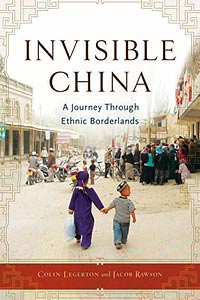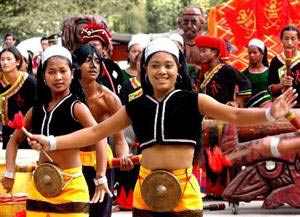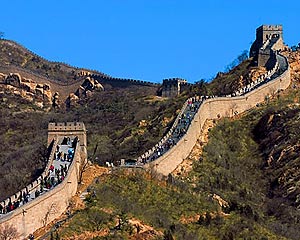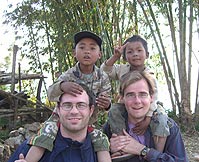
By Lisa Linsley
Colin Legerton and Jacob Rawson engage in an anthropological journey of more than 14,000 miles to encounter and reveal the ethnic minorities of China. Legerton and Rawson report on hidden, invisible minorities — their language, homes, cuisine, and school systems.
The focal point is to reveal their opinions of Chinese Government Policy and Han culture. However, even one without knowledge or interest in Chinese history will find this an enticing read through the authors’ immersion into the day-to-day lives and homes of these people through their journey. Revealing the history and public opinion of Chinese minorities through the current culture and systems produces an eye-opening read.
Without liquor, there is no ceremony.
Without liquor, there is no celebration.
-Wa saying
Excerpt: Valley of the Headhunters: The Wa
The road from the Kinh islands in the Gulf of Tonkin to the mountainous tropics in southern Yunnan takes three full days of uncomfortable travel. Masan, one of the last villages under Chinese control before the Myanmar border, is reached by a five-mile stone path, its only link to the rest of China.
Before the path’s completion, covering this distance required two hours of walking, but now we covered it in a mere forty minutes in the back of an “electric mule,” the local name for the local taxi: a three-wheeled motorcycle with a welded-on-flatbed.
Our arrival was ominous; next to the village’s moss-covered archway, a sun-bleached cow skull perched on top of a dreary wooden building seemed to be a warning to unwanted visitors. Walking down the only road through the village, the first person we encountered was equally unsettling: a scowling man with a cow skull necklace peered up at us from his front yard.
Massan is a Wa village. The Wa are an ethnic group of one million strong, occupying the borderland between China and Myanmar. About one-third of this population resides within the borders of China. Though primarily farmers, the Wa’s specific style of warfare, which included removing their enemies’ heads as trophies, left them with a distasteful reputation in the region.
Historically the Wa were seen as barbarians and feared by their neighbors on all sides. The first official Chinese account from Wa country, written in the late nineteenth century, did nothing to dispel the barbarian label, reinforcing fears that the Wa were head-hunters and adding to it unsubstantiated rumors of cannibalism.
“Skull Avenues”
Even decades into the twentieth century, did nothing to dispel the barbarian label, reinforcing fears that the Wa were headhunters and adding to it unsubstantiated rumors of cannibalism. Even decades into the twentieth century, British troops reported that “skull avenues”—paths lined with human skulls—led into every Wa village. When the communists set about defining the peoples of China, the Wa were classified as the most primitive ethnic group on the Marxist evolutionary scale.

We offered a timid hello as we passed the intimidating man, and watched his scowl melt into an ear-to-ear grin. He told us that he was on his way out, but invited us to come back to his house later. With a sigh of relief, we realized that we had clearly mistaken curious apprehension for aggression. We resolved to never again let historical prejudices shape our experiences.
Spirits lifted, we began to explore the village and take in the unique surroundings. Masan was perched on top of a deep valley. The mountains dropped out so steeply that a constant mist shrouded the valley floor, giving the impression that our mountain and others surrounding it were floating on a sea of clouds.
On the other side of the valley, we could make out a cluster of tiny bamboo huts nestled in a bamboo forest. Those were the beginnings of Myanmar.
Inside Mason, the vegetation and architecture were exceptionally diverse. On the fringes of the village, bamboo towered over the dirt paths and provided shade from the intense sun. Ruffled palm trees grew between houses and stretched down the steep hillside. Small pines littered the paths with clusters of cones.
Bamboo and Brick Houses
Some houses were made completely out of bamboo: the roofs were supported by bamboo pillars and the walls lined with bamboo strips while the entire living quarters were raised on bamboo stilts, allowing livestock to stand underneath. Others were built with bricks of cinder blocks with slogans stenciled on the side.

Most warned that EVERYONE IS RESPONSIBLE FOR PREVENTING DRUG USE, in clear response to the ongoing opium trade of the border region. An equally political slogan was scratched into the door frame of a bamboo home: I AM CHINESE, I LOVE CHINA. Unlike the others, this was written by a child’s hand in unsure characters, a permanent reminder of an elementary handwriting lesson.
Peppers and Corn
The paths were mostly quiet as we walked around the village that morning. White millet, peppers, and corn dried in shallow bamboo baskets on many rooftops. An old couple carrying multi-colored bags walked past us and offered a friendly greeting.
A family sat outside their home above an overgrown terraced garden, by turns watching us explore their village and watching their three baby warthogs run and grunt through the vegetable patch. Each home had at least one large clay pot drying outside, propped inverted on a fence post.
As we neared the end of a dirt lane, we could see workers on bamboo scaffolding, constructing a three-story brick building. The construction workers explained that this was to be the village’s new school, which they planned to have completed by the fall. In the meantime, students and teachers continued to use the old schoolhouse, a rectangular complex of one-story brick buildings arranged around a small patch of thin grass, all the while competing with the steady hammering of construction.
Morning Exercises
We arrived as the school day was beginning, and stood with the construction works watching from above as the PA system began to play music for the morning exercises. The students filed out of their dormitory and lines up on the middle field. Following a teacher’s lead, they conducted the athletic ritual, not a series of lethargic stretches and lunges set to a material beat as in much of China, but a rehearsed dance to a tape of Wa folk songs.
Another teacher then stepped to the front, lectured over steady hammering the need to study hard and rise to the top, and dismissed the students. We determined to revisit this school when they broke for lunch.
When we returned in the afternoon, the children were already at work on big bowls of rice. Three teachers sat on stools in a shaded corner of the schoolyard. They motioned us over and sent for a small wooden bench. We greeted them and were introduced around. First was Teacher Ma, the most talkative of the three, who had been teaching sixth grade at the school for ten years.
Han Chinese

His home and his wife were in another village, and he was only able to visit on weekends. He was Han, a native speaker of Chinese, but spoke with such a thick local accent that at first, we found it difficult to decipher even his most basic comments.
Across the way, separating rice noodles in a deep plastic tub was Teacher Ye, the music instructor. She briefly introduced herself, and then went back to the task at hand. She was Wa. Next to her was Principal Li, a newer arrival to the school than either of the two veteran teachers. He was short, with dark skin closer in Hue to Teacher Ye than Teacher Ma, so we took him to be Wa.
The School
By our request, Principle Li began to tell us about this school. It was 140 students from first through sixth grade. Sixty of them commute to school each morning on the village’s dirt paths, but the majority board at the school through the week, returning home only on weekends and holidays.
Most of the boarders live in another village, two hours’ walk around the mountains, directly on the Myanmar border. That village has facilities only for the first three years of elementary school, so its children move to Masan to continue their studies.
“After the students finish here, they board in the county seat for three years of middle school and then return back home,” Teacher Ma continued.
“High school isn’t required, and no one can afford the tuition. I didn’t even attend high school, and I’m in charge of a school now,” Principle Li joked. “My parents couldn’t afford the tuition back then, and the situation hasn’t really changed out here. Some of these families earn only eighty kuai a month. That’s not even enough to support themselves, let alone send a child to school in town.”
Buy this book from Amazon: Invisible China: A Journey Through Ethnic Borderlands

Lisa Linsley is a former intern at GoNOMAD and a journalism major at UMass Amherst.
- These 9 U.S. National Parks Require Reservations in 2024 - April 17, 2024
- Take a Hike in Olympic National Park - April 17, 2024
- The Wild Mississippi: 2340 Miles Across Ten States - April 8, 2024





